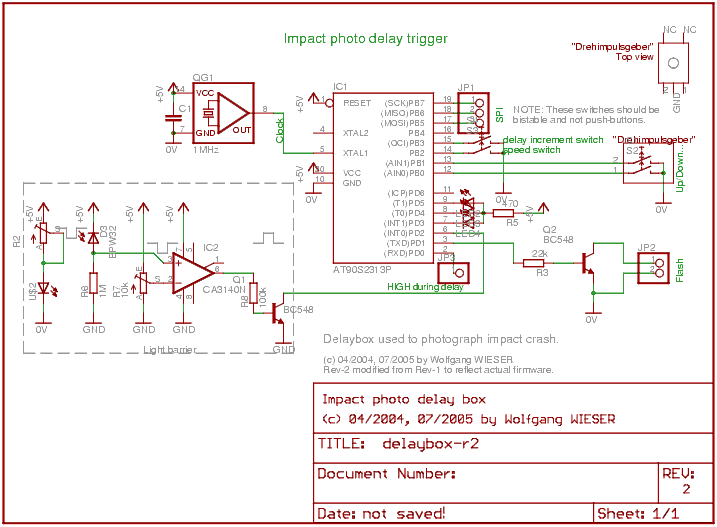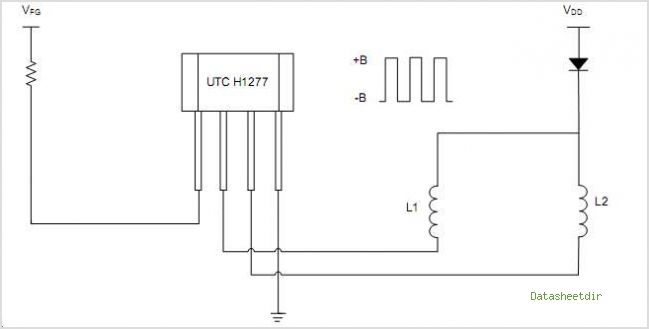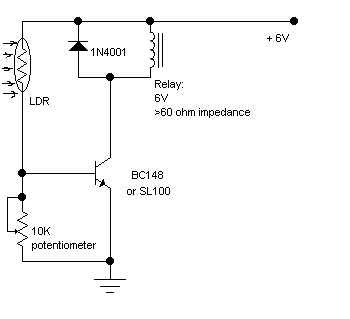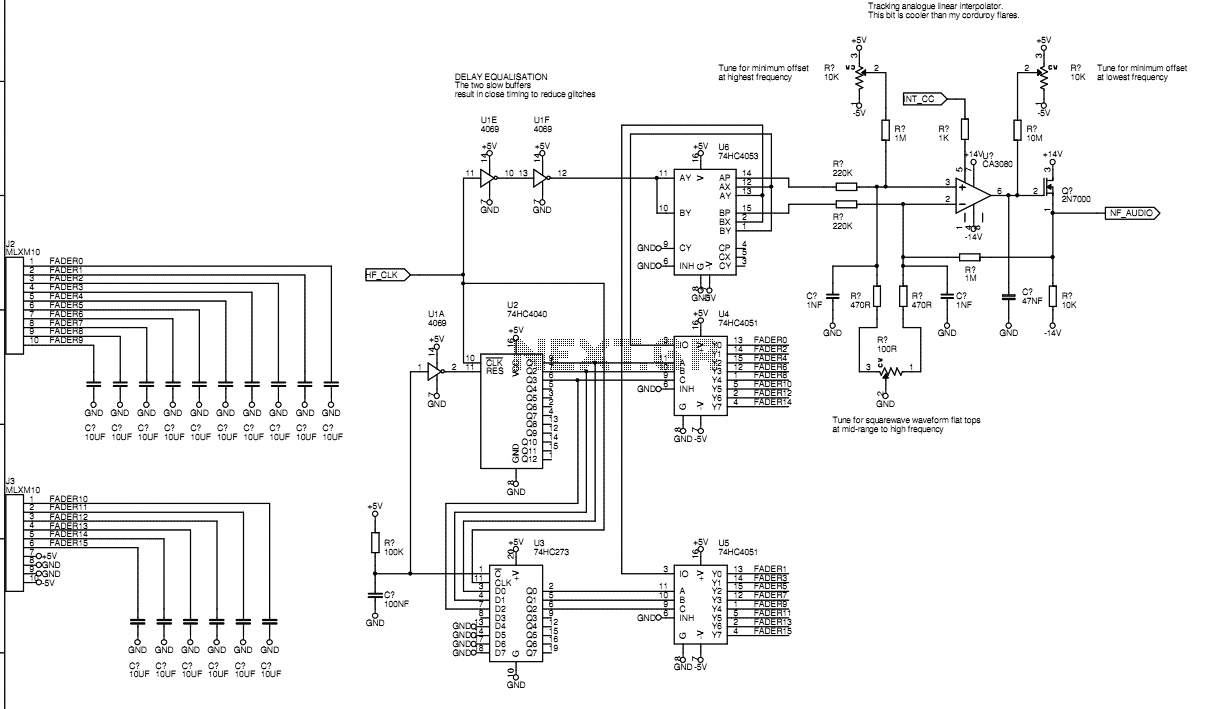
High resolution dithering bar graph display
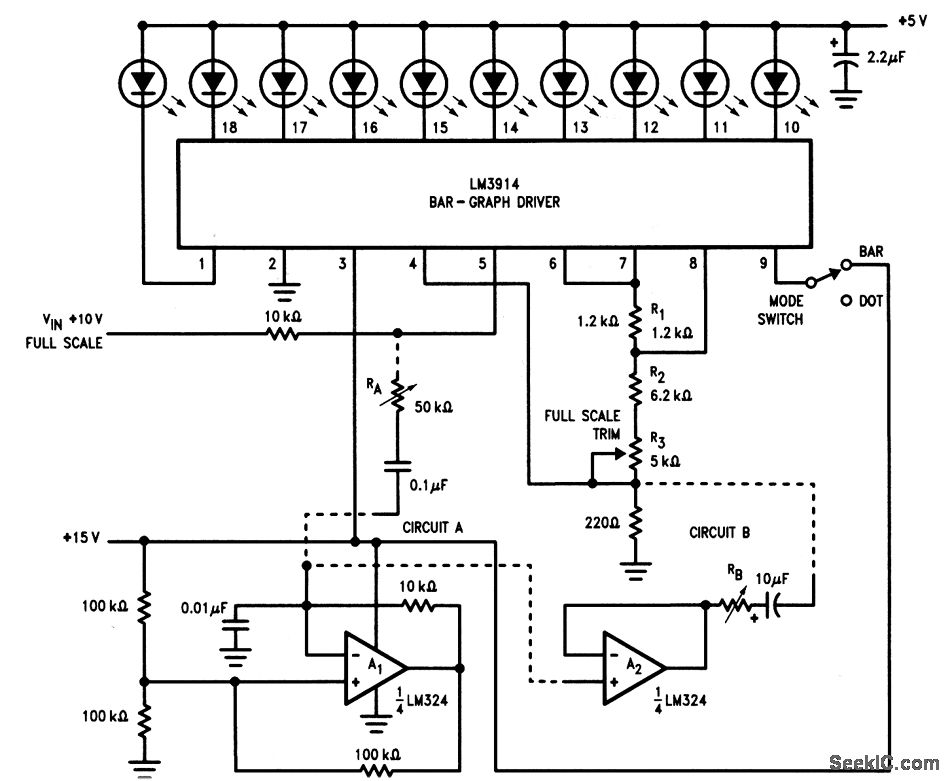
This circuit is an enhanced version of the display shown in Fig. 3-28, utilizing a triangular-wave oscillator. When the resistor RA is adjusted correctly, each incremental change in the input voltage (VIN) can be detected, allowing the glow from each LED to gradually transition from one device to the next. However, if the impedance of the signal source is high or non-linear, inaccurate readings may occur. In such cases, it is recommended to use CIRCUIT B to buffer the output of the oscillator. The display functions optimally in dot mode, where supply voltages can be increased up to 15 V. When operating in bar mode, it is crucial not to exceed +5 V on the LEDs to prevent overheating. For calibration, the LM3914 output should be set to full scale using resistor R3. Subsequently, resistors RA or RB should be adjusted so that when one LED is illuminated, any slight variation in VIN will activate one of the adjacent LEDs.
This circuit employs a triangular-wave oscillator to enhance the visual representation of input voltage changes through a series of LEDs. The design leverages the LM3914 LED bar graph/LED dot display driver, which can operate in either dot or bar mode depending on the application requirements. The use of a triangular-wave oscillator allows for a smooth transition of LED illumination, creating a visually appealing and informative display.
The circuit's performance is highly dependent on the correct configuration of the resistors RA and RB, which are used to set the sensitivity of the display. When RA is properly tuned, even minor fluctuations in VIN will activate adjacent LEDs, creating a cascading effect that enhances the readability of the display. This feature is particularly useful in applications requiring precise voltage monitoring.
In scenarios where the source of the input signal has a high impedance or exhibits non-linear characteristics, the circuit may produce misleading results. To mitigate this issue, the inclusion of CIRCUIT B, which acts as a buffer, is recommended. This buffer stage ensures that the oscillator output is stable and accurately reflects the input voltage, thus preventing erroneous readings.
The display's versatility is further highlighted by its operational voltage range. In dot mode, the circuit can handle supply voltages up to 15 V, accommodating a variety of applications. Conversely, in bar mode, it is essential to limit the voltage to +5 V across the LEDs to prevent thermal damage, ensuring longevity and reliability of the components.
Calibration of the circuit is a critical step in achieving optimal performance. Setting the LM3914 output to full scale using resistor R3 establishes a reference point for the display. Fine-tuning resistors RA and RB allows for precise adjustments, ensuring that the display responds accurately to voltage variations. This calibration process is vital for applications requiring high accuracy and responsiveness in voltage monitoring.
Overall, this circuit design exemplifies an effective approach to visualizing voltage changes using LED indicators, combining functionality with user-friendly features that enhance the monitoring experience.This circuit is an improved version of the Fig. 3-28 display, using a triangular-wave oscillator. With RA properly set, each incremental change in VIN can be detected because the glow from each LED can be made to spread gradually from one device to the next. If the signal-source impedance is high or not linear, false readings might occur. In this case, use CIRCUIT B to buffer the oscillator output. The display is most effective in the dot mode, where supply voltages can be brought up to 15 V. If bar mode is used, do not exceed +5 V on the LEDs (to avoid overheating). To trim, set the LM3914 output to full scale with R3. Then, adjust RA or RB so that when one LED is on, any small measured change of VIN will cause one of the adjacent LEDs to turn on. 🔗 External reference
This circuit employs a triangular-wave oscillator to enhance the visual representation of input voltage changes through a series of LEDs. The design leverages the LM3914 LED bar graph/LED dot display driver, which can operate in either dot or bar mode depending on the application requirements. The use of a triangular-wave oscillator allows for a smooth transition of LED illumination, creating a visually appealing and informative display.
The circuit's performance is highly dependent on the correct configuration of the resistors RA and RB, which are used to set the sensitivity of the display. When RA is properly tuned, even minor fluctuations in VIN will activate adjacent LEDs, creating a cascading effect that enhances the readability of the display. This feature is particularly useful in applications requiring precise voltage monitoring.
In scenarios where the source of the input signal has a high impedance or exhibits non-linear characteristics, the circuit may produce misleading results. To mitigate this issue, the inclusion of CIRCUIT B, which acts as a buffer, is recommended. This buffer stage ensures that the oscillator output is stable and accurately reflects the input voltage, thus preventing erroneous readings.
The display's versatility is further highlighted by its operational voltage range. In dot mode, the circuit can handle supply voltages up to 15 V, accommodating a variety of applications. Conversely, in bar mode, it is essential to limit the voltage to +5 V across the LEDs to prevent thermal damage, ensuring longevity and reliability of the components.
Calibration of the circuit is a critical step in achieving optimal performance. Setting the LM3914 output to full scale using resistor R3 establishes a reference point for the display. Fine-tuning resistors RA and RB allows for precise adjustments, ensuring that the display responds accurately to voltage variations. This calibration process is vital for applications requiring high accuracy and responsiveness in voltage monitoring.
Overall, this circuit design exemplifies an effective approach to visualizing voltage changes using LED indicators, combining functionality with user-friendly features that enhance the monitoring experience.This circuit is an improved version of the Fig. 3-28 display, using a triangular-wave oscillator. With RA properly set, each incremental change in VIN can be detected because the glow from each LED can be made to spread gradually from one device to the next. If the signal-source impedance is high or not linear, false readings might occur. In this case, use CIRCUIT B to buffer the oscillator output. The display is most effective in the dot mode, where supply voltages can be brought up to 15 V. If bar mode is used, do not exceed +5 V on the LEDs (to avoid overheating). To trim, set the LM3914 output to full scale with R3. Then, adjust RA or RB so that when one LED is on, any small measured change of VIN will cause one of the adjacent LEDs to turn on. 🔗 External reference
